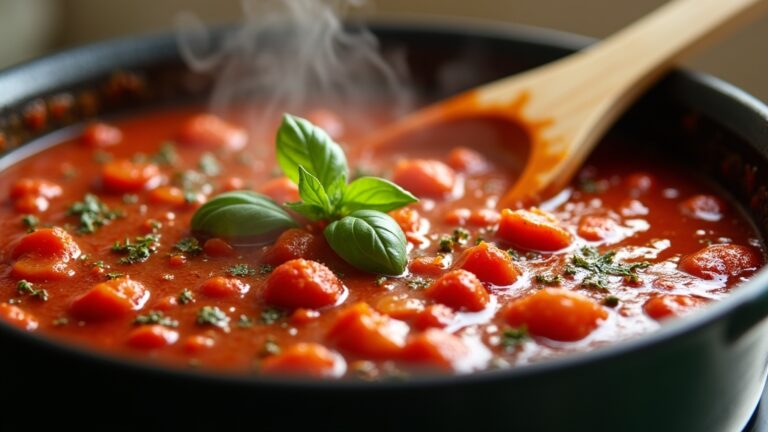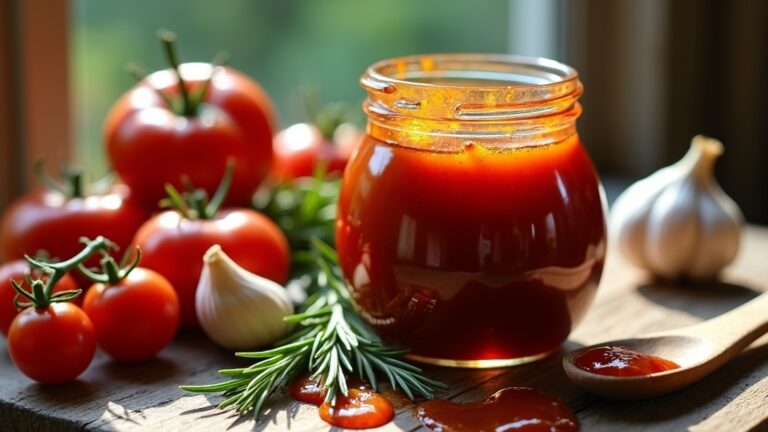Bechamel Sauce Recipe
I love making Béchamel sauce, a classic French white sauce that adds richness to many dishes. For the recipe, melt 2 tablespoons of unsalted butter, whisk in 2 tablespoons of flour to form a roux, then gradually add 2 cups of whole milk, stirring to avoid lumps. Season with salt, white pepper, and a pinch of nutmeg for extra flavor. This sauce is versatile and perfect for lasagnas and mac and cheese. Keep going to explore its uses and variations!
Contents
History
When I think about the history of béchamel sauce, I can’t help but marvel at its journey through culinary traditions. Originating in Italy, it found its way into French cuisine during the 17th century, thanks to chefs like François Pierre La Varenne. This creamy staple showcases the elegance of culinary techniques, combining butter, flour, and milk to create a rich base. Béchamel’s versatility is unparalleled; it serves as the foundation for countless dishes, from lasagna to creamy gratins. Its incorporation into French cuisine not only elevated dishes but also highlighted the importance of sauces in cooking. As I explore its evolution, I’m inspired by how this simple sauce continues to adapt and innovate in kitchens around the world, enriching our culinary landscape.
Recipe
Bechamel sauce, often referred to as white sauce, is a classic French sauce that serves as a foundation for many dishes. Its creamy texture and rich flavor make it a versatile addition to pasta, vegetables, and baked dishes like lasagna and moussaka. Mastering the bechamel sauce can elevate your culinary skills and impress your guests with your ability to create homemade sauces from scratch.
Bechamel sauce is a versatile French classic that enhances pasta, vegetables, and baked dishes, showcasing your culinary prowess.
To prepare bechamel sauce, you’ll need a few simple ingredients and a bit of patience. The key to a successful bechamel is to guarantee that your roux (the mixture of flour and butter) is cooked properly without browning, which sets the stage for the sauce’s smooth consistency. Once you have your ingredients ready, you can follow the straightforward steps to create this crucial sauce that forms the backbone of many great recipes.
Ingredients:
- 2 tablespoons unsalted butter
- 2 tablespoons all-purpose flour
- 2 cups whole milk
- Salt, to taste
- White pepper, to taste
- A pinch of nutmeg (optional)
To make the bechamel sauce, start by melting the butter in a medium saucepan over medium heat. Once the butter is fully melted and foamy, add the flour and whisk continuously for about 1-2 minutes to create a roux, guaranteeing it doesn’t brown. Gradually pour in the milk while whisking constantly to avoid lumps. Continue to cook the mixture, stirring frequently until it thickens and reaches a smooth, creamy texture. Season with salt, white pepper, and nutmeg if desired. Remove from heat and use immediately or store for later use.
When cooking bechamel sauce, it’s vital to whisk continuously to achieve a smooth texture. If you find that the sauce has thickened too much, you can easily adjust the consistency by adding a little more milk. Additionally, be mindful of the heat; cooking on high can cause the sauce to scorch. If you’re looking to enhance the flavor, consider infusing the milk with bay leaves or garlic before adding it to the roux. Finally, remember to taste the sauce before serving, as adjusting the seasoning can make a significant difference!
Cooking Steps
To make a perfect béchamel sauce, I start by melting butter in a saucepan over medium heat. Once the butter is fully melted, I add flour and stir it until it forms a smooth paste. Gradually, I pour in milk, whisking continuously to create a creamy consistency.
Step 1. Melt Butter in Saucepan
Start by placing a medium-sized saucepan over low to medium heat, then add the butter. I prefer using unsalted butter for its purity, but feel free to experiment with different butter types like clarified or herb-infused for added flavor. As the butter begins to melt, watch it closely to avoid browning—this is an essential melting technique that guarantees a smooth base for your béchamel. Stir gently with a wooden spoon, allowing the butter to melt evenly. You’ll notice it transforming from solid to liquid, creating a rich aroma that fills the kitchen. Once fully melted, it’s ready for the next step. This careful process sets the stage for a velvety sauce that elevates any dish.
Step 2. Add Flour and Stir
Once the butter has completely melted, I whisk in the flour, creating a roux that forms the foundation of our béchamel sauce. For this step, I prefer using all-purpose flour, known for its versatility, though alternatives like cake or whole wheat flour can add unique flavors. As I blend the flour into the butter, I make sure to use a steady, circular stirring technique, ensuring there are no lumps. This process takes just a few minutes; the goal is to achieve a smooth, golden mixture with a slightly nutty aroma. I keep the heat moderate to prevent burning, allowing the roux to develop its flavor while maintaining its creamy texture. Patience here is key for a perfect béchamel.
Step 3. Add Milk Gradually
With the roux ready and bubbling gently in the pan, it’s time to incorporate the milk. I start by pouring in a small amount of milk, whisking vigorously to guarantee a smooth blend. This gradual incorporation is essential; it helps achieve that perfect milk consistency we’re aiming for. As I add more milk, I keep whisking, watching the mixture transform from a thick paste to a creamy sauce. If I rush this step, I risk lumps ruining my bechamel. I continue this process until I’ve added all the milk, allowing it to thicken beautifully over medium heat. The result? A velvety sauce, ready to elevate any dish it graces.
Step 4. Season With Nutmeg
As I see the bechamel sauce bubbling gently, I know it’s the perfect moment to add a touch of nutmeg. This simple seasoning technique not only elevates the flavor but also introduces amazing nutmeg benefits. I sprinkle in just a pinch, and the aroma instantly transforms the sauce.
- It adds warmth, creating a cozy feel in every bite.
- The subtle sweetness complements the creaminess beautifully.
- Nutmeg’s unique complexity brings an innovative twist to classic dishes.
Incorporating nutmeg is a game-changer, allowing me to craft a bechamel that’s not just a base but a flavorful experience. Trust me, this small addition makes a world of difference in your culinary creations!
Step 5. Whisk Until Smooth
I grab my whisk and plunge into the sauce, blending it vigorously to guarantee a silky texture. Using effective whisk techniques, I make sure to reach every corner of the pot, preventing lumps from forming. As I whisk, I can feel the sauce transforming, becoming creamy and inviting. I focus on maintaining a smooth consistency, adjusting my speed to incorporate air without splattering. If I encounter any stubborn clumps, I apply a bit more pressure, ensuring they dissolve seamlessly. This stage is essential; the right technique leads to a flawless bechamel. Once I achieve that velvety finish, I can confidently move on, knowing my sauce is ready for whatever culinary creation awaits.
Nutritional Guide
Nutritional elements play an essential role in understanding the benefits of béchamel sauce. This creamy delight isn’t just about taste; it also offers nutritional benefits worth noting. When I whip up béchamel, I appreciate that it contains calcium from milk and essential fats from butter, contributing to a balanced diet.
Here’s a quick look at its nutritional profile:
| Nutrient | Amount per 100g | Benefits |
|---|---|---|
| Calories | 150 | Energy source |
| Calcium | 100 mg | Bone health |
| Fat | 10 g | Healthy fats |
| Carbohydrates | 8 g | Quick energy |
With a calorie content that’s manageable, béchamel can enhance various dishes without overwhelming your diet.
Final Thoughts
While béchamel sauce might seem like a simple addition to your culinary repertoire, its versatility and rich flavor can elevate a wide range of dishes. I’ve found that mastering this classic sauce opens doors to countless culinary uses, from creamy lasagnas to velvety mac and cheese. Here are three sauce variations to inspire your creativity:
- Mornay Sauce – Add cheese for a delicious twist perfect for gratins.
- Mustard Sauce – Incorporate mustard for a tangy kick, ideal for pairing with meats.
- Herb-Infused Sauce – Mix in fresh herbs to enhance your dishes with vibrant flavor.
Embrace the potential of béchamel, and don’t hesitate to experiment. Your culinary journey will be richer for it!
Frequently Asked Questions
Can I Substitute Milk With a Non-Dairy Alternative?
Absolutely, I’ve found non-dairy options like almond or oat milk work great. They create creamy textures in alternative recipes, maintaining flavor without sacrificing richness. Experimenting with these can lead to delicious, innovative dishes you’ll love!
How Long Can I Store Leftover Bechamel Sauce?
Storing saucy scraps safely is simple! I usually keep leftover storage in an airtight container for about three to four days. After that, the sauce’s shelf life diminishes, so enjoy it soon for the best flavor!
What Are Common Dishes That Use Bechamel Sauce?
I love incorporating béchamel into dishes like creamy mac and cheese and rich lasagna recipes. This versatile sauce elevates flavors, adding a luscious texture that transforms classic meals into innovative culinary experiences. It’s simply irresistible!
Can I Freeze Bechamel Sauce?
Did you know that about 30% of homemade sauces get wasted? I’ve successfully frozen bechamel sauce using proper freezing techniques, maintaining its smooth consistency. Just remember to cool it first for best results!
What Thickening Agents Can I Use Instead of Flour?
When I need thickening agents instead of flour, I often reach for cornstarch alternatives like arrowroot powder. They create smooth textures, blend easily, and offer a gluten-free option that’s perfect for innovative cooking adventures.
Conclusion
To sum up, mastering béchamel sauce opens up a world of culinary possibilities. Imagine inviting friends over for a cozy dinner, where you drape creamy béchamel over homemade lasagna, the aroma filling the air as it bubbles in the oven. Each bite reveals layers of rich flavor, creating a comforting atmosphere that sparks joyful conversations. With this versatile sauce in your repertoire, you’re not just cooking; you’re crafting delicious memories that linger long after the last bite.






